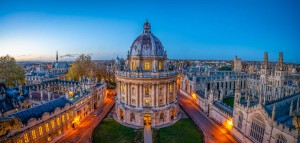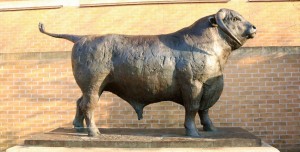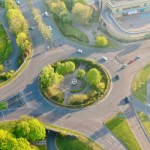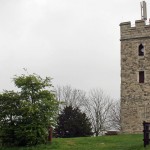
Oxford is renowned for being home to one of the oldest, most prestigious, universities in all of the world – not just in the UK. It carries a reputation that opens political and career doors all around the globe, with few exceptions. But Oxford isn’t just a university… it’s a town, first.

Image: Pajor Pawel/Shutterstock.com
Oxford; it’s more than an internationally acclaimed university town, although we’re not yet sure how it could be better than that…
Today we are talking Oxford: the history, the fun things about it, the best parts of visiting Oxford, and more. Stick with us for the full summary, or head to our home pages at Five Minutes Spare to read through some of our other town tours. Try Sheffield, for example, or learn bout the best points of Glasgow. We might even have covered your home town!
To Oxford, then, let’s give it the full rundown.
Early History of Oxford
Sometime in the 9th Century, Alfred the Great decided he needed to strengthen the somewhat loose borders between Mercia and Wessex. To do so, he went up and down the country, building forts and burghs to strengthen his grip on the land. One of those fortified towns on the Thames was Oxford, a battlefront town that bordered the two, often conflicting regions.
England wasn’t always in England. Back in those early times, the whole country was divided into separate kingdoms. Only when these were united in the 10th century, did England truly exist. Before this, we refer to the people as Saxons, or Britons, because they weren’t really English. The Saxons is the name given to those people that lived in what is now England, in the years after the Romans retreated. As such, they were the descendants of Germanic people who had often mixed with native Britons.
Anyway… Back to Oxford, where the Saxons called the town “Oxnaford” before Alfred the Great built the fortified town. Of the city, before that, we know very little. There has been evidence of Roman kilns uncovered in Oxford and there is a “Roman Way” through the town. However, it seems that Ancient Rome passed Oxford by, at least for the most part.
When it was recognised as a strategically important border in pre-England times, it was fortified and the town took off in growth. It was also on the Thames, near the mouth, which put it into direct danger from Viking invasions.
The Vikings would have shown up in the 8th century and kept coming until the 11th century. Oxford was repeatedly attacked, eventually being completed razed to the ground in 1009 as revenge for the St Brice’s Day Massacre… when the king of England told his people to murder Danes. In 1018, Oxford was repaired enough to be the place where the Danelaw held its conference over who would be King of all England. When they rebuilt Oxford, they built it out of stone. In an excavation back in the early 2000s, 30 skeletons were discovered. It is believed they were victims of the Massacre.
The Norman Conquest Onwards
Again, the newly rebuilt Oxford took heavy damage during the Norman Conquest of 1066. It is estimated that the population at that time would have been around 5,000 people. It reportedly had a mint, a market place, and an annual fair. After the invasion, the Normans established a firm grasp over Oxford by building a castle here and placing a Norman firmly in charge.
By 1086, when the Domesday Survey was completed, Oxford had already reached its peak point. It had grown to be almost half the size of London. It was fortified with a raised earth palisade and a wooden stockade. These would later be made into walls, and eventually would be mostly lost to time as the city expanded.
At the time of Domesday, Most of Oxford was claimed by the king. It made him hundreds of pounds a year and included a number of churches, a few mills, 5 lots of ploughlands and men to plough them, 105 acres of meadow, 8 acres of woodland and numerous tenants.
When one of the many English civil wars broke out in the early 1100s, Queen Matilda was besieged in Oxford Castle. There is a delightful tale about her escaping across the frozen lake and living to tell the tale. Again: the town was wrecked. Again: the people of the city rebuilt. A strong Jewish community is noted in the city around the same time.
The University Is Born
In 1167, Oxford finally became the university town it is known for being today. The students and the people of the town didn’t really get on at first. Oxford people were workers and the students were seen as a class above. In the early 12th century a woman in town was murdered. 2 students were hanged in retaliation. The majority of the students fled to Cambridge University instead but were later forgiven and invited to come home again. It was this incident that sparked the friendly rivalry and strange bond between the two universities began.
So… after being ignored by the Romans, razed by the Vikings, invaded by other Englishman, conquered by the Normans, and then setting about each other: the people of Oxford started rioting. They rioted all the way through the 13th century, mostly because the students kept getting given extra rights, better benefits, and basically all the money that the people felt the town should be getting. In 1355, the two groups fought for three days, only for the king to resolve this by granting the students even more rights.
At the time, the workers in Oxford were famed for their wool. There was a whole city worth of jobs, though. From bakers to blacksmiths, leather workers to clothiers. As a whole, though, the town wasn’t as wealthy as it had been before all that fighting.
The 12th century saw a priory built, a 13th-century leper hostel was added, and friars lived in the area until the fifteenth century, when Henry VIII turned them all out. By the start of the 16th century, there were around 35,000 people in Oxford, with frequent outbreaks of plague. The 1600s ended with another civil war, a great fire, and the first ever UK coffee shop. By the start of the industrial era, Oxford was clean, paved, and had a working sewer system. It had already gone through so much history that other towns were jealous.
Let’s break for some fun time… we all need a breather.
Fun Trivia about Oxford
If you are spending time in Oxford and you need some fun facts to bring up at parties, we have enough for everyone here. Below are some of the Five Minutes Spare favourites:
- The first-ever recorded mile in under four minutes was run here by Roger Bannister, in 1964.
- The only University in the world that is older than Oxford is Bologna university.
- There are 21 Oxfords in the USA, yet ours has not twinned with any of them.
- Oxford’s name may come from a low point in the river, once known as a fjord. The oxen bred in this region could cross there, and of course, later a bridge was built.
- The university has produced 28 Nobel Prize winners… and she’s still going.
- Some famous names that have attended the university include former PM David Cameron, Rupert Murdoch, actress Kate Beckinsale and even Hugh Grant.
- In times of trouble, the English king and parliament sometimes move. During the English Civil War (the last one, in the 1600s), the town was made the capital city
There’s so much history in this town that you could throw a dart and find something interesting. A little research is all it takes.
Oxford in the Industrial Era
Skipping forward slightly to the 1800s, Oxford got its second wind in the industrialisation processes. At the start of the 19th century, the town was mainly dependent on the economic needs of the University. On one hand, the building was always adding campuses. On the other, this pushed prices up for the locals. By the 1800s they had a charity school, a music room, and an infirmary. There was also a workhouse for those too poor to survive.
In 1819, there were around 12,000 people in the city. Gas street lamps lit the cobbled streets and sewers had been added – that didn’t empty into the same river everyone washed in. A water company was taken over by the city council for sanitation purposes and piped water made it to the houses. Nevertheless, there were a great number of diseases and cholera outbreaks.
During Henry VIII’s daughter Mary’s reign, 3 martyrs had been burned for being protestants during her father’s era. In 1843, the three martyrs got their memorial. The railway from London arrived in 1844, bringing a wealth of new business to town. The National History Museum was built and electricity arrived in 1892. Interestingly, marmalade making, iron smelting and book publishing were the three main industries not entirely dominated by the university.
The Modern Oxford
Asides from having several students sign up for and go off to both world wars, Oxford remained mainly unchanged by the trouble in Europe. They were never heavily industrialised, so Hitler had no need to bomb them. Lots of housing estates were added at the turn of the century to accommodate the growth from the 1800s. By 1910 they had a cinema, but the biggest change during this period was the building of the Morris Minor car manufacturing operation in 1913. They remained one of the largest employers in town, right up until the 70s.
1924 saw the opening of the Museum of the History of Science, followed by the addition of Hinksey Park in 1934. In 1938 they got their own airport, with a hospital being added in 1940. The 50s and 60s saw yet more housing estates erected, several shopping centres added, and St Clare’s College opening. In 1966, the Gallery of Modern Art opened, with the College of Further Education making more students flock to the area as of 1972. Since then, we have seen the Museum of Oxford in ’75, the Ferry Pool in ’76, the Science park in the nineties, and numerous other changes and additions to the town.
We have to stop there because we will run out of space if we don’t. Needless to say that Oxford has had far too much history for us to squeeze it in to a few pages. It is synonymous with English culture: a beacon to all that approach the entrance to the Thames and, occasionally, has even served as a deterrent to those that might do so. The population now stands at over 150,000 people, a far cry from its 12,000 people low points. We sincerely hope that it never experiences those low points again.
Famous People from Oxford
We mentioned before that there have been a number of famous faces that have attended the university – but not all of them lived in, or were born in, the city. Luckily for you, the Five Minutes Spare team have already looked out for the most recognisable famous people from Oxford for you to enjoy. Behold:
- Stephen Hawking, the late, great, physicist, was born to a family of Doctors in Oxford.
- Dr House himself – Hugh Lawrence – both studied and lived in the city.
- Jamie Lang, off the telly, was born here.
- Gugu Mbatha-Raw, the actress, is from here.
- Sophie, Countess of Wessex, is an Oxford
There are so many others, too. Oxford has had plenty of generations to form famous people from… These are just a few of the recent ones. Now that we have most of the pleasantries out of the way, let’s get down to the business of tourism… Why should you go to Oxford on holiday?
Attractions in Oxford
What is there to do in this historically abundant town? If you were to stay here for a few days, we advise that you try to visit the following sights:
Historic Sights and Landmarks
There’s the university, but we’re not going into that. You will notice they have the biggest church spire in town, too. This belongs to the University church of St Mary’s. Other religious places of worship and Instagram picture opportunities can be found in Christ Church Cathedral, the Trinity Church, and St Aldates Church. If you do stop by the Cathedral, take enough extra time to enjoy a walk around the Meadows outside. You will be able to enjoy the beautiful gardens there.
The Carfax Tower was built in the 13th century. It was built as an addition to St Martin’s Church – and is all that remains of it. It sits at the centre of the city cross, a reminded that time takes its toll, even on the church.
Dominating the landscape of the city, you will be able to make out the walls of the ancient Oxford Castle. From 1071 all the way up until the ’90s, Oxford Castle was used as a place to hold prisoners. The castle regularly runs re-enactments and is often open for tours. Staff are incredibly knowledgable about the history of the castle, so do ask.
Take a tour of the amazing Bodleian Library inside the University. Even if you have no interest in the students or their studies, this is one of the most impressive libraries in the world… not to mention one of the oldest that has seen continuous use.
Galleries and Museums
The Pitt Rivers Museum is a firm favourite of tourists, every year. They have a number of exhibits on the history and culture of the area, as well as a number of interesting historical artefacts from far flung reaches of the world. Pop along for an interesting afternoon out.
The OU Museum of Natural History is the favoured attraction in the whole of the city. You should take a wander around some of the most spectacular exhibits in the UK. Their collection of historical artefacts is internationally acclaimed. Here, you will find catalogued collections of species, recorded in stuffed and replica animal forms.
As a third choice in museums, you can visit the Ashmolean Museum of Art and Archaeology, which make an interesting combination. Follow artworks of humanity, all the way from cave paintings to album art. It features interesting exhibits that explore our culture from angle we don’t often think about.
Outdoor Attractions
Of course, the University also has the outdoor attractions covered in this city. They have a massive, and equally impressive, Botanic Garden. You can wander it for about two hours before you see it all. It’s gorgeous, overflowing with plants you don’t normally see in the UK, and just waiting for you to explore.
If you are looking for a large outdoor space to explore around Oxford, then you might check out the Port Meadow area for a large park. There is a pond, lots of forest walks, and wildlife and nature for the young ones to enjoy. There are lots of dog walkers and maybe even a few picnicking families.
Sports and Recreation
The local football team is Oxford United FC, who play at the Kassam Stadium and who regularly welcome other teams to challenge them. Take a tour, catch a game, or buy a shirt to show your support. If you prefer rugby, you can visit the Oxford RFC page, here. As for golf, you can try the North Oxford Golf Club, the Hinksey Heights Golf Club, or the Oxford Golf Club, to improve your holiday swing.
Shopping and Retail
The city centre is a brightly coloured, old-style of architecture, with plenty of options in unique little shops. Some sell gifts, some sell clothing, some sell bric-a-brac, but all are divine to wander around. If you can’t find what you are looking for there, try Westgate, it has everything.
Other Notable Oxford Attractions
Oxford is packed end-to-end with stuff that will entertain you. It is this sense of adventure that makes it a brilliant destination for an at-home holiday. Whether you are just passing through or intend to stay for a while, here are some other points of interest to add to your Oxford travel itinerary:
- The Oxford Artisan Distillery – people love this brewery tour, we just weren’t sure which category it fell under.
- Magdalene College is a stunning old building, but we got sick of talking about student buildings.
- The Sheldonian Theatre is a massive place with plenty of shows. It is generally used for graduation ceremonies. If it’s too big, check out the Creation Theatre Company to see what they are doing.
- Take the kids to Partyman World of Play for an indoor soft play adventure day.
- Don’t forget the History of Science Museum…
There are dozens of other things to see and do in Oxford city. We hope we have managed to give you a fair idea of what’s on offer, so you can plan for your holiday accordingly.
How to Get to Oxford?
We have almost caught you up to speed with all things Oxford. The last thing we have to tell you, though, is how to get there. It’s not hard really, just follow the Thames out of London.
By Road
Follow the M4 until you get to the M40, then head to Oxford.
By Rail
Great Western Rail is in charge of Oxford Station. Look out for the rather impressive bronze statue if you arrive by train.

Image: dagma/Shutterstock.com
By Air
Heathrow airport in London is closest to you and you can catch the bus to it every two hours. There is also Oxford International Airport with less choice in flights.
By Sea
Afraid not, although they are on the Thames. The nearest beach is East Cowes Beach, about 68 miles away.
Five Minutes Spare
Here at Five minutes Spare, we specialise in helping you find the best UK location destination for you. If you want to head north, south, east or west, for a UK staycation, we have the scoop on dozens of destinations. Drop by our main pages and have a look for yourself.


